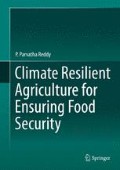Abstract
In the last decade, an overwhelming consensus has emerged among scientists that the world has entered an era of rapid global climate change, much of which is attributable to greenhouse gas (GHG) emissions from human activity. Rapid global climate change is expected to impact agriculture by causing shifts in temperature, precipitation, soil quality, pest regimes, and seasonal growth patterns. The exact nature and degree of these changes for any given region will be difficult to predict. At the same time that the agricultural sector is impacted by climate change, research indicates that current agricultural activities are a significant source of greenhouse gases that aggravate climate disruption. The amount of GHGs emitted from an agricultural operation depends on its system and management.
To cope with climate change that is likely to be both rapid and unpredictable, agricultural systems must be resilient and able to adapt to change. Resilient agriculture systems are those that are more likely to maintain economic, ecological, and social benefits in the face of dramatic exogenous changes such as climate change and price swings. In the face of uncertainty, food production systems should be established which are diverse and relatively flexible, with integration and coordination of livestock and crop production.
Sustainable and organic agricultural systems can help reduce agricultural GHG emissions through energy conservation, lower levels of carbon-based inputs, lower use of synthetic fertilizer, and other features that minimize GHG emissions and sequester carbon in the soil. Agricultural land can serve as a sink for GHG emissions, especially through soil carbon sequestration, which could help moderate climate change. But agricultural land can serve as an effective GHG sink over the long term only if agricultural systems are adopted which improve overall soil quality and provide for relatively stable GHG reduction or sequestration. Agricultural crop and forage production system features include, among others, fertilizer use and efficiency, nitrogen sequestration, and overall GHG emissions of associated livestock production systems.
Access this chapter
Tax calculation will be finalised at checkout
Purchases are for personal use only
References
Conforti P (ed) (2011) Looking ahead in world food and agriculture: perspectives to 2050. FAO, Rome
Easterling WE, Aggarwal PK, Batima P, Brander KM, Erda L, Howden SM, Kirilenko A, Morton J, Soussana JF, Schmidhuber J, Tubiello FN (2007) Food, fibre and forest products. In: Parry ML, Canziani OF, Palutikof JP, van der Linden PJ, Hanson CE (eds) Climate change 2007: impacts, adaptation and vulnerability. Contribution of Working Group II to the fourth assessment report of the Intergovernmental Panel on Climate Change. Cambridge University Press, Cambridge, pp 273–313
FAO (2009) The state of food and agriculture: livestock in the balance. FAO, Rome
FAO (2012a) Climate-smart agriculture: managing ecosystems for sustainable livelihoods. FAO, Rome
FAO (2012b) Annex 2: approaches to rapid assessments of impacts of climate variability and climate change on agriculture in the project area. Incorporating climate change considerations into agricultural investment programmes: a guidance document. FAO, Rome. Available at http://www.fao.org/docrep/016/i2778e/i2778e.pdf
Foresight (2011a) The future of food and farming: challenges and choices for global sustainability. Final project report. The Government Office for Science, London. Available at http://www.bis.gov.uk/assets/foresight/docs/food-and-farming/11-546-future-of-food-and-farming-report.pdf
Foresight (2011b) Foresight project on global food and farming futures. Synthesis report C1: Trends in food demand and production
IPCC (1997) Revised 1996 IPCC guidelines for national greenhouse gas inventories workbook, vol 2. Cambridge University Press, Cambridge
IPCC (2007) Climate change 2007: impacts, adaptation and vulnerability. In: Parry ML, Canziani OF, Palutikof JP, van der Linden PJ, Hanson CE (eds) Contribution of Working Group II to the fourth assessment report of the Intergovernmental Panel on Climate Change. Cambridge University Press, Cambridge/New York
OECD & FAO (2010) Agricultural outlook 2010–2019. Food and Agriculture Organization of the United Nations, Rome
Smith P, Martino D, Cai Z, Gwary D, Janzen H, Kumar P, McCarl B, Ogle S, O’Mara F, Rice C, Scholes B, Sirotenko O (2007) Agriculture. In: Metz B, Davidson OR, Bosch PR, Dave R, Meyer LA (eds) Climate change 2007: mitigation. Contribution of Working Group III to the fourth assessment report of the IPCC. Cambridge University Press, Cambridge/New York
UNEP (2010) Assessing the environmental impacts of consumption and production: priority products and materials. In: Hertwich E, van der Voet E, Suh S, Tukker A, Huijbregts M, Kazmierczyk P, Lenzen M, McNeely J, Moriguchi Y (eds) A report of the Working Group on the Environmental Impacts of Products and Materials to the International Panel for Sustainable Resource Management
World Bank (2008) Climate change impacts in drought and flood affected areas: case studies in India. Report No. 43946-IN
Author information
Authors and Affiliations
Rights and permissions
Copyright information
© 2015 Springer India
About this chapter
Cite this chapter
Reddy, P.P. (2015). Introduction. In: Climate Resilient Agriculture for Ensuring Food Security. Springer, New Delhi. https://doi.org/10.1007/978-81-322-2199-9_1
Download citation
DOI: https://doi.org/10.1007/978-81-322-2199-9_1
Published:
Publisher Name: Springer, New Delhi
Print ISBN: 978-81-322-2198-2
Online ISBN: 978-81-322-2199-9
eBook Packages: Biomedical and Life SciencesBiomedical and Life Sciences (R0)

